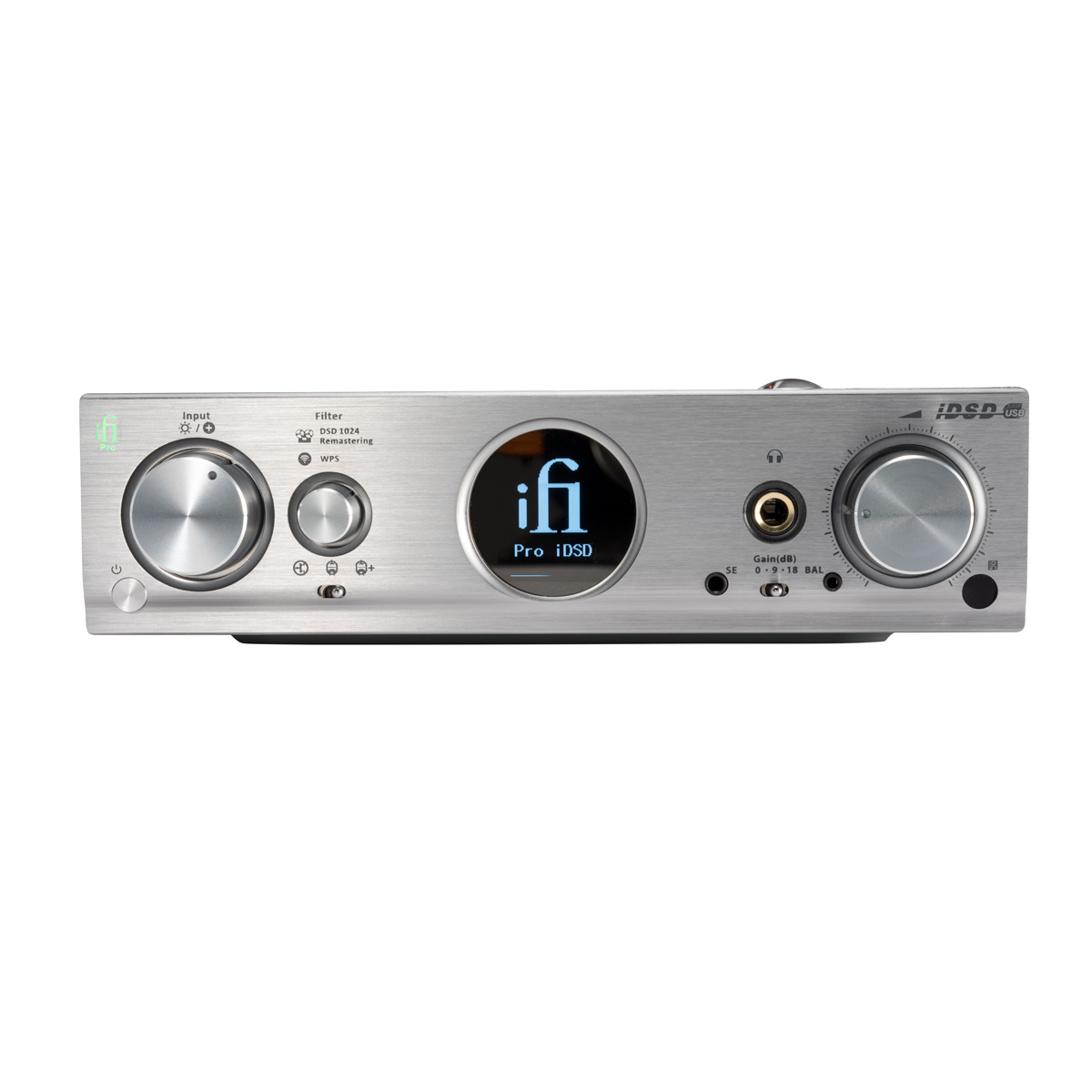Editors' Choice Award 2019 – The Absolute Sound
"Highly Recommended" – Herb Reichert, Stereophile
Ground-Breaking Pro-Quality DSD DAC with Selectable Tube or Solid State Output Stage
The Pro iDSD DAC from iFi Audio is an all-out assault on the state-of-the-art. Its ground breaking digital engine will be used across the next generation of iFi products, and, like all the best things in life, it has taken its time to come to market. But, oh boy, is it worth the wait! Especially with its user-selectable tube/solid-state analog stage.
The iFi Pro DSD won an Editors' Choice Award 2019 from The Absolute Sound. According to the magazine, "Few DAC/Preamps at any price offer greater technical sophistication or flexibility," reports the March 2019 issue.
The Pro iDSD uses the new XMOS XU216 X-Core 200 Series 16-Core processor with a maximum calculation power of 2,000 MIPS (2 Billion Instructions per second) in dual-issue mode as a USB interface. The X-Core 200 handles the decoding of signals from all inputs, be it USB (up to 768 kHz / DSD512), AES/EBU or S/PDIF (up to 192 kHz / 24-Bit) and Wifi, network, mass-storage (up to 192 kHz / 32-Bit).
And check out this cool feature. You can choose the solid-state output stage for your listening or a tube output stage featuring the General Electric NOS 5670 vacuum tube for glorious 'Golden Age' hi-fi sound.
Every section in the Pro iDSD has received massive attention to detail! Classic design techniques for very low-noise design found in Tube equipment have been combined with the latest 21st Century tech to deliver extreme performance.
"The Most Feature-Packed and Configurable DAC We’ve Ever Tested"
"iFi Audio's Pro iDSD lived up to the hyperbole of its owner's manual. It did actually play music like "a 'state of the art' reference digital to analog converter," reports Herb Reichert January 3, 2019 issue of Stereophile. "It did indeed sound like 'an all-out assault' on what is possible in DACs today . . . and it did both of those good things at a ridiculously low price. Highly recommended."
"The iFi Pro iDSD is probably the most feature-packed and configurable DAC we’ve ever tested," notes an October 19, 2018 review in England's What Hi-fi? magazine. "This unit, partnered with a good pair of active speakers… would make a neat and capable system."
Quad DAC Section
Get ready to rock your digital world with the iPro iDSD. It uses a Quad 'stack' of the iFi Bit-Perfect DSD and DXD DAC by Burr-Brown in a custom 'interleaved' configuration. Put simply, this means a total of 8 pairs of differential signals are used and mixed (4 pairs of signals per channel).
A Field Programmable Gate Array (FPGA) takes care of digital re-mastering – the FPGA's specialty. The Pro iDSD then uses four interleaved 64-Element D/A converters, resulting in a 256 Element DAC per channel. As always, these are manufactured to iFi's high level of precision – precision not achieved by adding discrete DACs. All signals to the DACs are re-clocked with the low-jitter Global Master Timing master clock derived from the AMR DP-777.
Studio DSD Re-mastering – Bitperfect or Upsampled
The Pro iDSD makes the perfect sound engineer! Just like a good studio re-master, it can produce Bit-Perfect without employing ASRC or upsampling. If you do want upsampling, just select the digital filters embedded in the Crysopoeia FPGA Digital Engine. Different digital filters (including Bit-Perfect mode without digital filtering) are selectable on demand.
Hi-Res Network Audio with Full MQA Decoding
In addition to traditional inputs, the Pro iDSD integrates a Wifi / network playback system, with built-in Spotify and Tidal (and other streaming services). It offers wide protocol support including Airplay and USB Memory/Hard Drive/SD Card playback. This makes it a full standalone streamer/network audio player with 32 Bit/192kHz and DSD64 support.
It offers a plethora of playback options to suit any system, starting with Airplay Network Audio Playback from your iPhone, iPad, or Mac Computer and DLNA Network Audio Playback from your smartphone, tablet, and Windows/Linux computer. It also offers playback from your hard drive, USB Memory or SDHC Memory Card, playback from Network Attached Storage (NAS), and streaming playback. including Amazon Music, Audible, Spotify, TIDAL, Napster, Spotify Connect, and QQPlay. And because Pro iDSD is the flagship of the iFi fleet, it has full MQA decoding onboard for maximum quality playback, be it via MQA music files or streaming.
Zero Jitter Memory Buffer for All Inputs
There is no shake, rattle, or roll when it comes to inputs. For all inputs, data is sent to a large 'elastic' Memory Buffer, where it is de-jittered to eliminate any transmission of source jitter to the DAC output. The data from the Memory Buffer is further re-clocked by the low-jitter Global Master Timing clock, which also drives the X-Core 200 and FPGA.
Studio Remastering, Upsampling, and Digital Filtering
Although the X-Core 200 is optimal for USB Audio, AES, EBU, SPDIF decoding and decoding MQA, DSD, etc, it is not the best platform for DSP, digital filters, and PCM-to-DSD conversion. So, the other half of this dynamic duo of digital processing is Studio DSD Re-mastering. At the heart beats the Crysopeia FPGA Digital Engine for digital filtering and PCM to DSD re-mastering, up to DSD1024.
Upsampling and digital filtering is where FPGA excels! Upsampling in the hardware itself allows the Pro iDSD to overcome the current USB limitation of DSD512. Furthermore, it can also implement multiple filters optimized for specific time-domain behavior, including that of the DAC and analog stage for a level of optimization not possible in generic software 'upconversion' (as found in Foobar, for example).
The five filters available are 'Bit-Perfect' (no digital filtering is applied, 1 Tap), 'Bit-Perfect+' (no digital filtering is applied, 1 Tap), 'Minimum Phase' (minimum filtering, no pre-ringing, minimum post ringing, 32 Taps), 'Apodising' (modest filtering, no pre-ringing, modest post ringing, 128 Taps), and 'Transient Aligned' (max filtering, max Pre-Ringing, maximum Post-Ringing, 16,384 Taps).
Full Galvanic Isolation
Galvanization rules! All inputs are galvanically-isolated (including USB). The USB Input is self-powered and does not draw power from the USB bus. We don't expect the USB section to be impervious to after-market add-ons or tuning accessories.
Cutting-Edge SPDIF technology
The S/PDIF etc. digital inputs use technology derived from the AMR DP-777, including a new, solid-state implementation of HD-VDi, memory buffer and the Global Master Timing clock system. The S/PDIF etc. inputs are not expected to benefit much from any kind of tweaking or tuning gizmos.
External Clock options & Synchronization
For synchronization in recording studios the Pro iDSD supports AES3id based DARS (Digital Audio Reference Signal) according to AES11. And if you happen to have a really good atomic clock to hand, (at least a Sanford Research Systems PERF10), this can be used to further elevate the Pro iDSD over the internal clock system. The iFi flagship definitely deserves this over specification. It's worth it.
Passive Filtering and Discrete Analog Stage
The DACs operate 'Voltage Output Mode,' giving >119dB dynamic range. All filtering is passive, using a fully-balanced 3rd order capacitor/inductor/capacitor filter to remove ultrasonic noise directly after the DAC rather than active, feedback-based circuits. Active filters struggle with the amount of ultrasonic noise and RFI they have to handle and, at a few 100 kHz, they often lose the ability to filter noise at all, which is precisely where a lot of noise is present. And who wants noise? Not us!
Using passive CLC filtering in the Pro iDSD provides the correct filtering well into the megahertz region, so that the analog stage that follows is spared the burden of handling ultrasonic noise and RFI originating with the DAC processes. Directly after the DAC and filter is the analog domain volume control, which can be bypassed for the line outs. This uses a 6-Track Alps Japan potentiometer.
In actual fact, the analog stage is more precisely a line/headphone driver stage, fully-balanced, fully-discrete, direct-coupled (coupling capacitor less), Tube/Solid-State user-selectable stage! Phew! This was first seen in the Pro iCAN. The actual discrete design is not just an Op-Amp made discrete (often worse than the best integrated ones!), but radically different, pure Class A circuitry. Here, iFi drew on inspiration from legendary studio equipment with exceptional, killer sound.
Power Supplies
All incoming DC is converted to a high-frequency waveform and then rectified and filtered by a choke input capacitor filter (that is straight out of classic tube design, updated to 21st Century technology). This produces a first-level DC bus from which all further voltages are derived. This circuit also generates a galvanically-isolated power supply voltage for the USB input circuitry.
The digital section is powered by a bank of Super Capacitors totaling 6.6 Farad (6,600,000uF). Elna Dynacap DZ Super capacitors have around 400 times lower internal impedance compared to common grades of super capacitors are used to avoid the typical drawback of the very impedance of common 'Super Capacitors.' The 'Super Capacitor' bank is charged through a large value inductor from the main DC bus.
Individual low-noise TI LDO Regulators with local LC filtering provide the final low-noise power for all individual digital sections, a total of six individual regulators cover Clock, S/PDIF Input and the DAC's digital section.
The USB input section has its own separate power management system with multiple regulators and filtering operating from the galvanically-isolated voltage generated to power this section.
For the analog stage, higher voltages (especially for the Tubes) are needed. The whole analog stage in effect, operates on 60V rail, giving massive potential dynamic range. These are generated from the main DC Bus and are filtered using multiple stages of inductor/Capacitor filters, with Elna Silmic Capacitors forming the final stage of this filter.





























